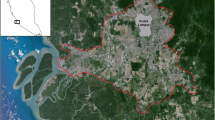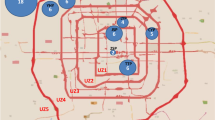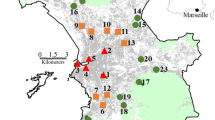Abstract
The conservation value of urban parks for butterfly communities remains poorly understood, particularly for tropical butterflies in Asia. We conducted point count and route transect butterfly surveys, and used them to sample four habitats located within 13 urban parks across Hong Kong. We found 1054 individuals and 58 species of butterflies recorded in 60 survey hours over 6 months. This represents approximately one quarter of the entire known Hong Kong butterfly species list. Over 30 % of the individuals counted were Catospilia sp. but six of the species identified are classified locally as rare or very rare. Tree-covered habitats and grasslands showed higher butterfly diversity than open areas. The most common butterfly behavior was “directed flight,” which we also found to be habitat-dependent and most common in ponds and open areas. We additionally observed the use of vegetation in urban parks, which included 40 species of nectar plant and four records of butterfly oviposition. The high butterfly diversity, presence of rare species and usage of vegetation (especially as a nectar resource) we documented in this study suggests that urban parks have some conservation value for Hong Kong. However, the use of pesticides and heavy vegetation clearing may limit significant butterfly reproduction and population growth. Altogether these results emphasize the diversity of uses of urban parks for butterflies in Hong Kong while also providing possible directions for improvement in habitat and vegetation management that could increase urban park value for biodiversity.




Similar content being viewed by others
References
Bascombe MJ, Johnston G, Bascombe FS (1999) The Butterflies of Hong Kong. Academic, London
Blair RB, Launer AE (1997) Butterfly diversity and human land use: species assemblages along an urban gradient. Biol Conserv 80:113–125
Bonebrake TC, Cooper DS (2014) A Hollywood drama of butterfly extirpation and persistence over a century of urbanization. J Insect Conserv 18:683–692
Bonebrake TC, Ponisio LC, Boggs CL, Ehrlich PR (2010) More than just indicators: a review of tropical butterfly ecology and conservation. Biol Conserv 143:1831–1841
Braaker S, Ghazoul J, Obrist MK, Moretti M (2014) Habitat connectivity shapes urban arthropod communities: the key role of green roofs. Ecology 95:1010–1021
Brown KS Jr, Freitas AVL (2002) Butterfly communities of urban forest fragments in Campinas, São Paulo, Brazil: structure, instability, environmental correlates, and conservation. J Insect Conserv 6:217–231
Chan A, Cheung J, Sze P, Wong A, Wong E, Yau E (2011) A review of the local restrictedness of Hong Kong butterflies. Hong Kong Biodivers 21:1–12
Chong KY, Teo S, Kurukulasuriya B, Chung YF, Rajathurai S, Tan HTW (2014) Not all green is as good: different effects of the natural and cultivated components of urban vegetation on bird and butterfly diversity. Biol Conserv 171:299–309
Clark PJ, Reed JM, Chew FS (2007) Effects of urbanization on butterfly species richness, guild structure, and rarity. Urban Ecosyst 10:321–337
Conradt L, Roper TJ (2006) Nonrandom movement behavior at habitat boundaries in two butterfly species: implications for dispersal. Ecology 87:125–132
R Core Team (2014) R: a language and environment for statistical computing. R Foundation for Statistical Computing, Vienna, Austria. URL http://www.R-project.org/
Corlett RT (2005) Interactions between birds, fruit bats and exotic plants in urban Hong Kong, South China. Urban Ecosyst 8:275–283
Dearborn DC, Kark S (2010) Motivations for conserving urban biodiversity. Conserv Biol 24:432–440
Di Mauro D, Dietz T, Rockwood L (2007) Determining the effect of urbanization on generalist butterfly species diversity in butterfly gardens. Urban Ecosyst 10:427–439
Dormann CF, Strauss R (2013) Detecting modules in quantitative bipartite networks: the QuaBiMo algorithm. arXiv preprint arXiv:1304.3218
Dormann CF, Gruber B, Fründ J (2008) Introducing the bipartite package: analyzing ecological networks. R News 8:8–11
Fattorini S (2011) Insect extinction by urbanization: a long term study in Rome. Biol Conserv 144:370–375
Fellowes JR, Lau WN, Dudgeon D, Reels GT, Ades GWJ, Carey GJ, Chan PL, Roger CK, Lee KS, Leven MR, Wilson KDP, Yu YT (2002) Wild animals to watch: terrestrial and freshwater fauna of conservation concern in Hong Kong. Mem Hong Kong Nat Hist Soc 25:123–159
Giuliano WM, Accamando AK, McAdams EJ (2004) Lepidoptera-habitat relationships in urban parks. Urban Ecosyst 7:361–370
Global Invasive Species Database (GISD) (2010) Sphagneticola trilobata (herb). http://www.issg.org/database/species/ecology.asp?si=44&fr=1&sts=sss&lang=EN. Accessed 30 May 2014
Goddard MA, Dougill AJ, Benton TG (2010) Scaling up from gardens: biodiversity conservation in urban environments. Trends Ecol Evol 25:90–98
Graves SD, Shapiro AM (2003) Exotics as host plants of the California butterfly fauna. Biol Conserv 110:413–433
Grimm NB, Faeth SH, Golubiewski NE, Redman CL, Wu J, Bai X, Briggs JM (2008) Global change and the ecology of cities. Science 319:756–760
Hong Kong Herbarium (HKH) (2014) Hong Kong Plant Database. http://herbarium.gov.hk/Search_Form.aspx. Accessed 30 May 2014
Jahner JP, Bonilla MM, Badik KJ, Shapiro AM, Forister ML (2011) Use of exotic hosts by Lepidoptera: widespread species colonize more novel hosts. Evolution 65:2719–2724
Kattwinkel M, Biedermann R, Kleyer M (2011) Temporary conservation for urban biodiversity. Biol Conserv 144:2335–2343
Koh LP, Sodhi NS (2004) Importance of reserves, fragments, and parks for butterfly conservation in a tropical urban landscape. Ecol Appl 14:1695–1708
Kowarik I (2011) Novel urban ecosystems, biodiversity, and conservation. Environ Pollut 159:1974–1983
Lee CM, Park JW, Kwon TS, Kim SS, Ryu JW, Jung SJ, Lee SK (2015) Diversity and density of butterfly communities in urban green areas: an analytical approach using GIS. Zool Stud 54:1–12
Leisure and Cultural Services Department (LCSD) (2013) Quality services for quality life 2012-2013 annual report. http://www.lcsd.gov.hk/dept/annualrpt/2012-13/en/divider.html. Accessed 30 May 2014
Lo YF, Hui WL (2005) Hong Kong Butterflies. Agriculture, Fisheries and Conservation Department, Hong Kong
Lowe S, Browne M, Boudjelas S, De Poorter M (2000) 100 of the world’s worst invasive alien species: a selection from the global invasive species database. Published by The Invasive Species Specialist Group (ISSG) a specialist group of the Species Survival Commission (SSC) of the World Conservation Union (IUCN), 12pp. First published as special lift-out in Aliens 12, December 2000. Updated and reprinted version: November 2004
Matteson KC, Langellotto GA (2010) Determinates of inner city butterfly and bee species richness. Urban Ecosyst 13:333–347
Matteson KC, Langellotto G (2012) Evaluating community gardens as habitat for an urban butterfly. Cities Environ 5: article 10
McIntyre NE (2000) Ecology of urban arthropods: a review and a call to action. Ann Entomol Soc Am 93:825–835
McKinney ML (2002) Urbanization, biodiversity, and conservation. Bioscience 52:883–890
Nielsen AB, van den Bosch M, Maruthaveeran S, van den Bosch CK (2014) Species richness in urban parks and its drivers: a review of empirical evidence. Urban Ecosyst 17:305–327
Öckinger E, Van Dyck H (2012) Landscape structure shapes habitat finding ability in a butterfly. PLoS ONE 7, e41517
Öckinger E, Dannestam Å, Smith HG (2009) The importance of fragmentation and habitat quality of urban grasslands for butterfly diversity. Landsc Urban Plan 93:31–37
Oksanen J, Blanchet FG, Kindt R, Legendre P, Minchin P, O’Hara R, Simpson GL, Solymos P, Stevens MHH, Wagner H (2010) vegan: community ecology package. R package version 2.2-0. URL http://CRAN.Rproject.org/package=vegan
Pun SF, Tam KC (2011) Hong Kong Butterfly Watching Guide Book. Tai Po Environmental Association Fung Yuen Butterfly Reserve, Hong Kong
Raupp MJ, Shrewsbury PM, Herms DA (2010) Ecology of herbivorous arthropods in urban landscapes. Annu Rev Enomol 55:19–38
Rodrigues JJ, Brown KS Jr, Ruszczyk A (1993) Resources and conservation of neotropical butterflies in urban forest fragments. Biol Conserv 64:3–9
Shreeve TG, Dennis RLH (2011) Landscape scale conservation: resources, behaviour, the matrix and opportunities. J Insect Conserv 15:179–188
Shwartz A, Turbé A, Simon L, Julliard R (2014a) Enhancing urban biodiversity and its influence on city-dwellers: an experiment. Biol Conserv 171:82–90
Shwartz A, Turbé A, Julliard R, Simon L, Prévot AC (2014b) Outstanding challenges for urban conservation research and action. Glob Environ Chang 28:39–49
Slade EM, Merckx T, Riutta T, Bebber DP, Redhead D, Riordan P, Macdonald DW (2013) Life-history traits and landscape characteristics predict macro-moth responses to forest fragmentation. Ecology 94:1519–1530
Soga M, Yamaura Y, Koike S, Gaston KJ (2014) Woodland remnants as an urban wildlife refuge: a cross-taxonomic assessment. Biodivers Conserv 23:649–659
van Langenberg A (2006) Urban gardening: a Hong Kong gardener’s journal. The Chinese University Press, Hong Kong
Young JJ, Law YS, Choi KP, Pun SF, Yau SM, Chor HK, Lam W (2011) A photographic monograph on Hong Kong butterflies (volume 4). Hong Kong Lepidopterists’ Society Limited, Hong Kong
Acknowledgments
We thank the Leisure and Cultural Service Department for granting permission to undertake research in the urban parks of Hong Kong. Moreover, KCT would like to thank Mr. Pun Sui Fai whose knowledge sharing and experience in butterfly watching and breeding in Hong Kong has been invaluable. We thank Mrs. Poon Choi Hei Yin for assistance in plant identification. Toby Tsang and Melanie Chan provided helpful input on the manuscript.
Author information
Authors and Affiliations
Corresponding author
Electronic supplementary material
Below is the link to the electronic supplementary material.
ESM 1
(XLSX 13 kb)
Rights and permissions
About this article
Cite this article
Tam, K.C., Bonebrake, T.C. Butterfly diversity, habitat and vegetation usage in Hong Kong urban parks. Urban Ecosyst 19, 721–733 (2016). https://doi.org/10.1007/s11252-015-0484-2
Published:
Issue Date:
DOI: https://doi.org/10.1007/s11252-015-0484-2




